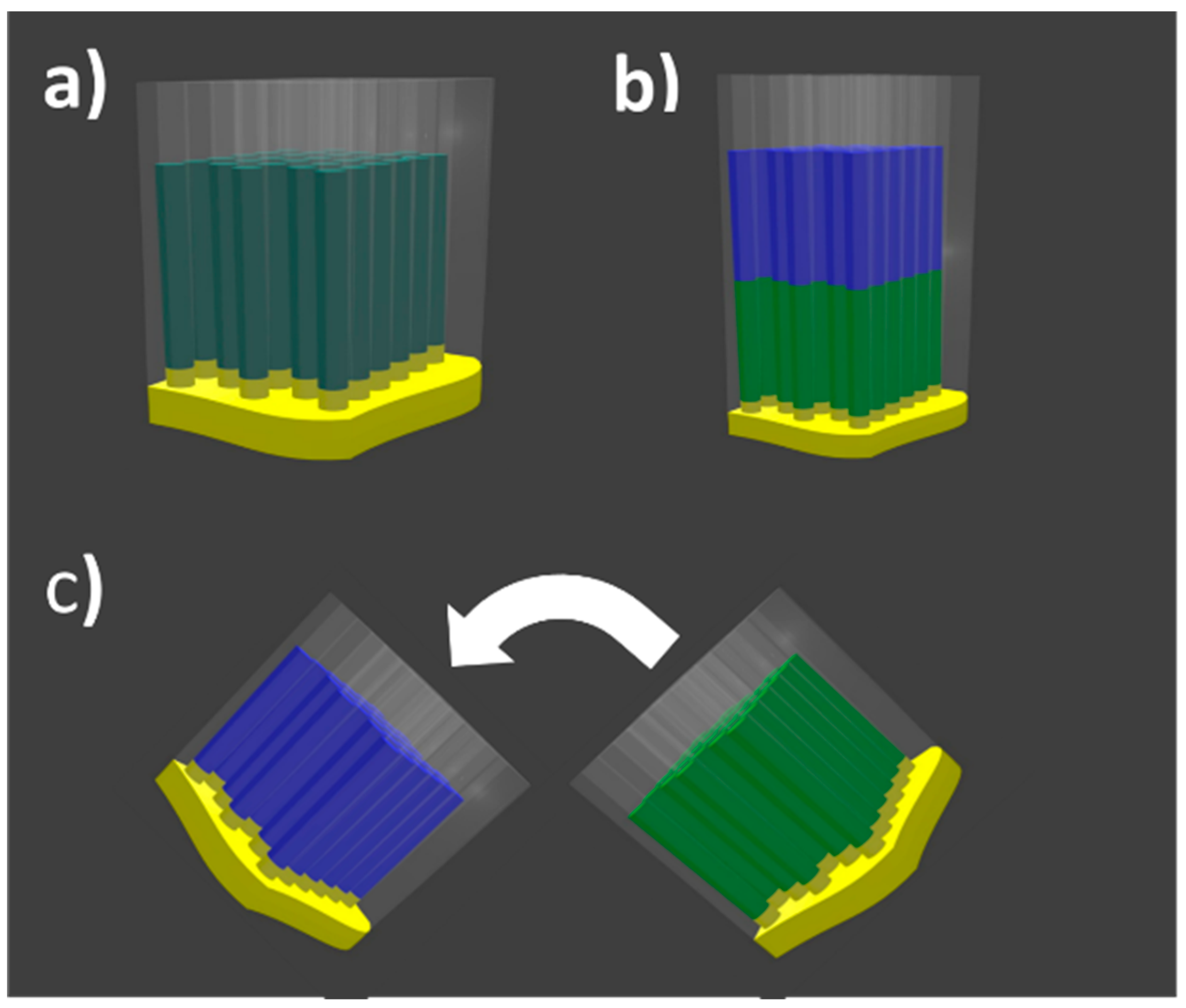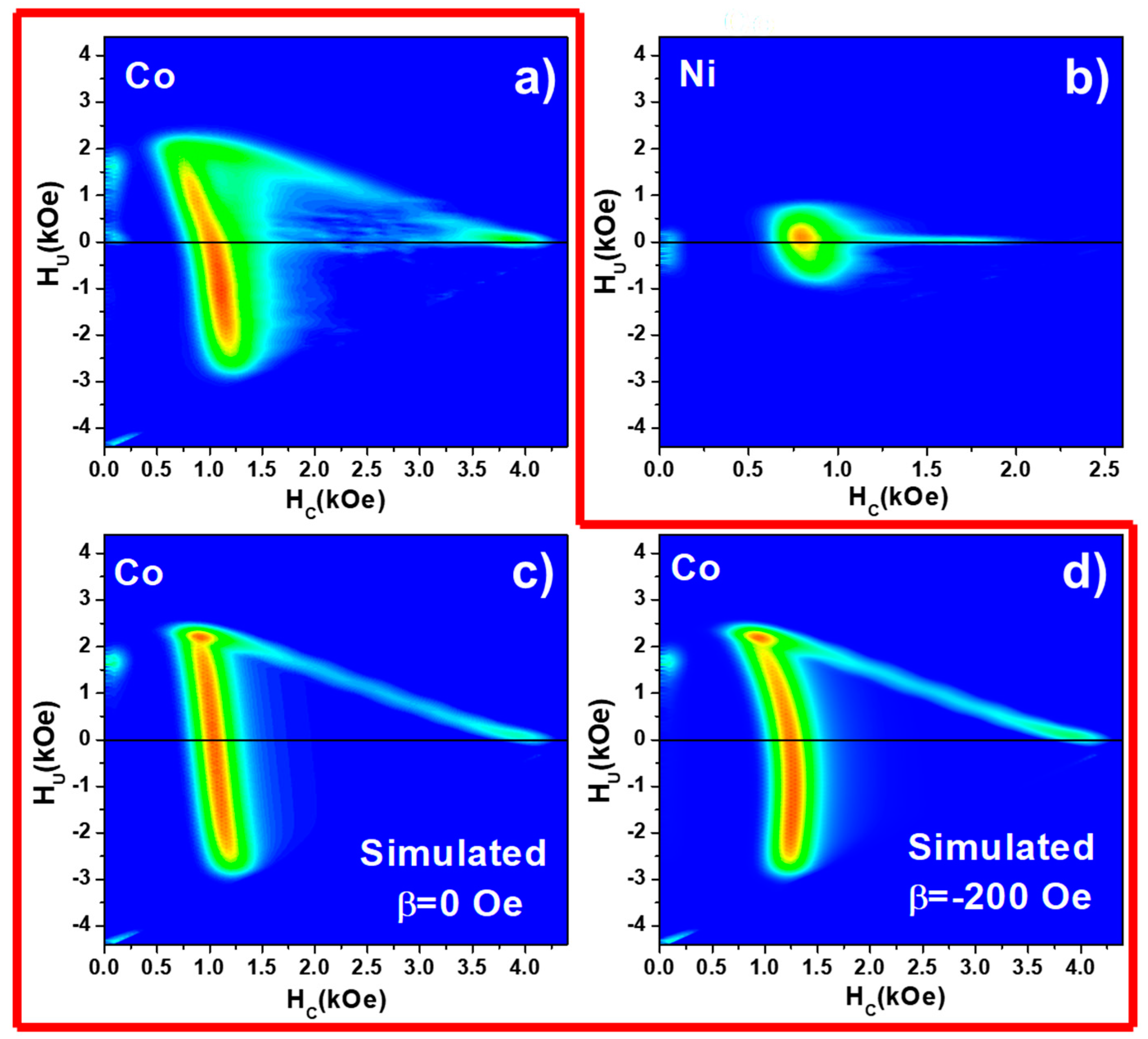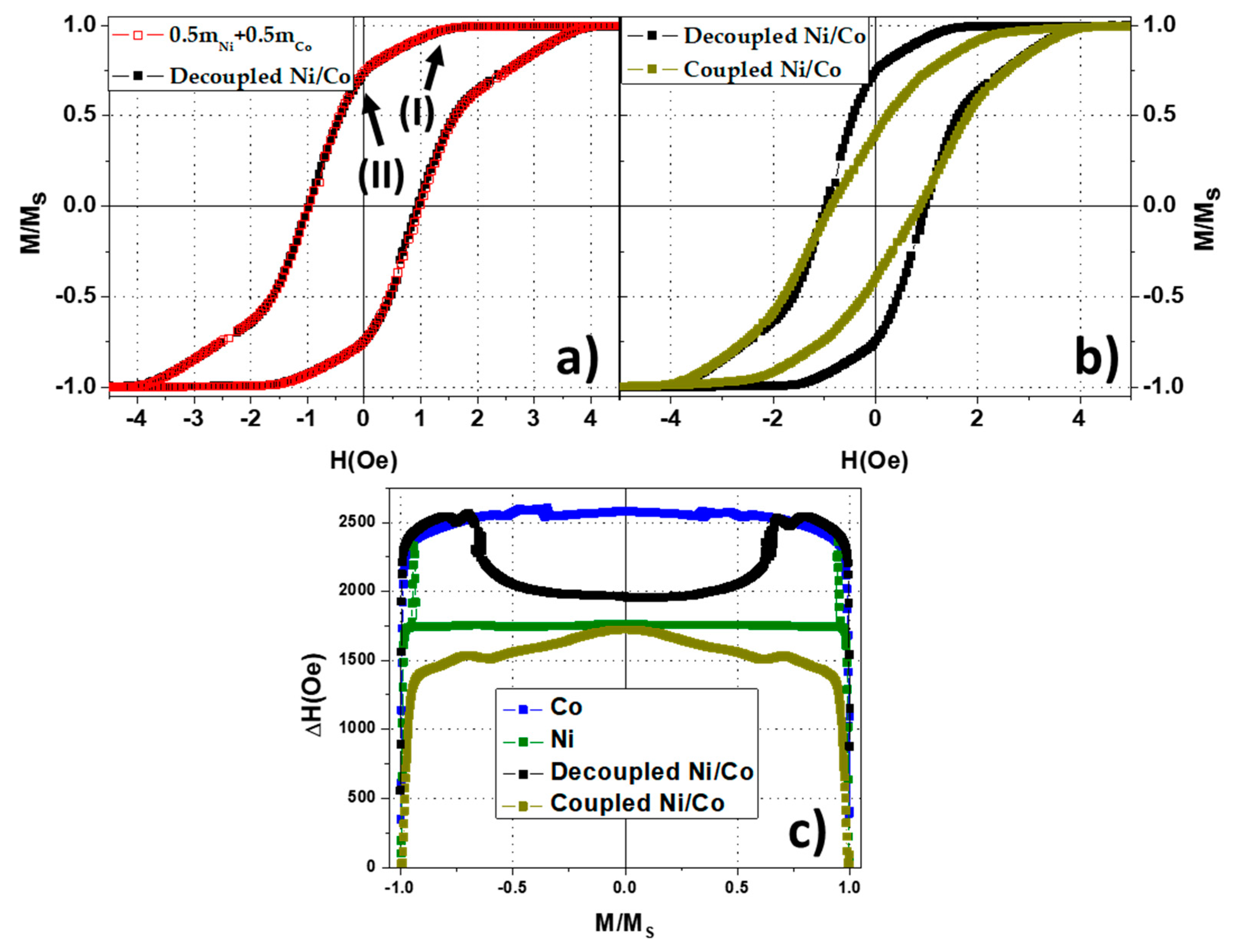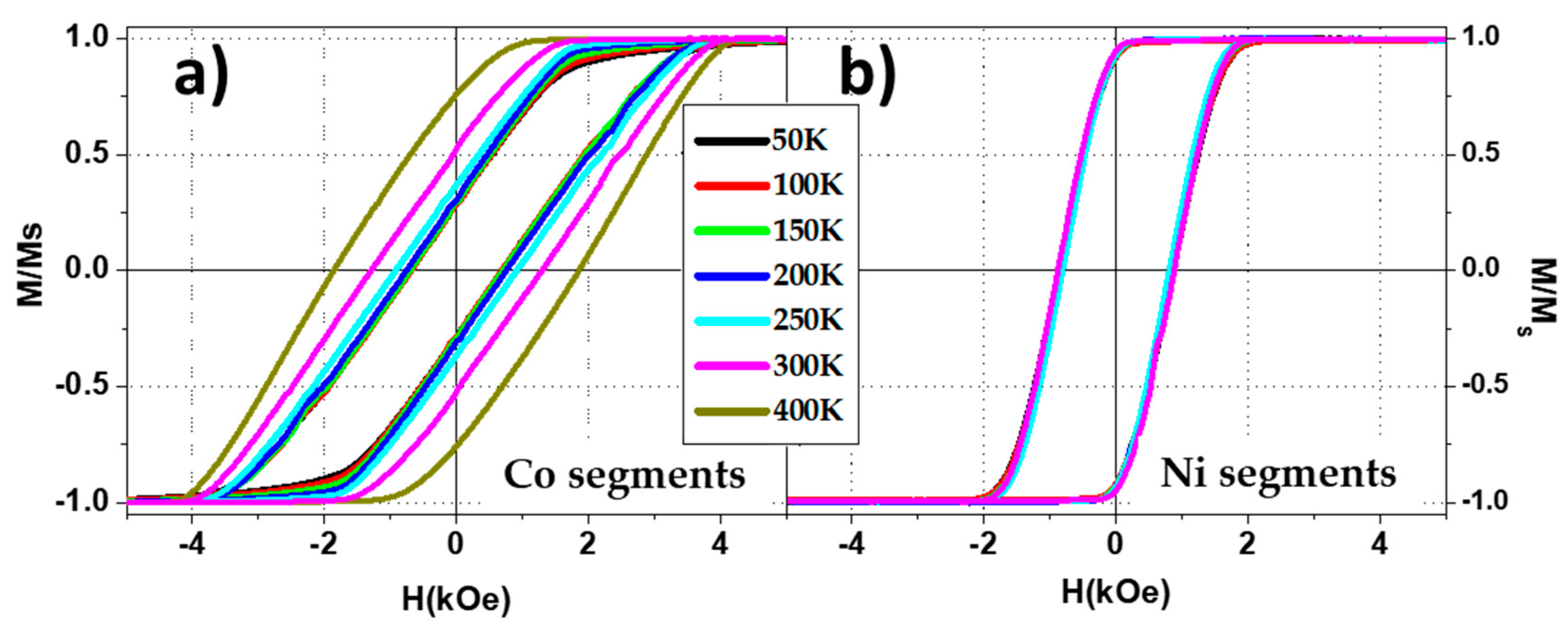Two-Step Magnetization Reversal FORC Fingerprint of Coupled Bi-Segmented Ni/Co Magnetic Nanowire Arrays
Abstract
1. Introduction
2. Materials and Methods
2.1. Samples Fabrication and Characterization
2.2. Statistical Approach of Modelling FORC Simulations
3. Results and Discussion
3.1. Ni and Co Nanowire Arrays
3.2. Coupled and Decoupled Ni/Co Bi-Magnetic Systems
4. Conclusions
Author Contributions
Funding
Acknowledgments
Conflicts of Interest
References
- Béron, F.; Pirota, K.R.; Vega, V.; Prida, V.M.; Fernández, A.; Hernando, B.; Knobel, M. An effective method to probe local magnetostatic properties in a nanometric FePd antidot array. New J. Phys. 2011, 13, 013035. [Google Scholar] [CrossRef]
- Sousa, C.T.; Leitao, D.C.; Proenca, M.P.; Ventura, J.; Pereira, A.M.; Araujo, J.P. Nanoporous alumina as templates for multifunctional applications. Appl. Phys. Rev. 2014, 1, 031102. [Google Scholar] [CrossRef]
- Prida, V.M.; Vega, V.; García, J.; Iglesias, L.; Hernando, B.; Mínguez Bacho, I. Electrochemical Methods for Template-Assisted Synthesis of Nanostructured Materials; Vázquez, M., Ed.; Woodhead Publishing: Cambridge, UK, 2015; ISBN 978-0-08-100164-6. [Google Scholar]
- Prida, V.M.; García, J.; Hernando, B.; Bran, C.; Vivas, L.G.; Vázquez, M. Electrochemical synthesis of magnetic nanowires with controlled geometry and magnetic anisotropy. In Woodhead Publishing Series in Electronic and Optical Materials; Vázquez, M., Ed.; Woodhead Publishing: Cambridge, UK, 2015; pp. 41–104. ISBN 978-0-08-100164-6. [Google Scholar]
- Nielsch, K.; Müller, F.; Li, A.-P.; Gösele, U. Uniform Nickel Deposition into Ordered Alumina Pores by Pulsed Electrodeposition. Adv. Mater. 2000, 12, 582–586. [Google Scholar] [CrossRef]
- Vázquez, M.; Hernández-Vélez, M.; Pirota, K.; Asenjo, A.; Navas, D.; Velázquez, J.; Vargas, P.; Ramos, C. Arrays of Ni nanowires in alumina membranes: magnetic properties and spatial ordering. Eur. Phys. J. B 2004, 40, 489–497. [Google Scholar] [CrossRef]
- Mourachkine, A.; Yazyev, O.V.; Ducati, C.; Ansermet, J.-P. Template Nanowires for Spintronics Applications: Nanomagnet Microwave Resonators Functioning in Zero Applied Magnetic Field. Nano Lett. 2008, 8, 3683–3687. [Google Scholar] [CrossRef] [PubMed]
- Salem, M.S.; Sergelius, P.; Corona, R.M.; Escrig, J.; Gorlitz, D.; Nielsch, K. Magnetic properties of cylindrical diameter modulated Ni80Fe20 nanowires: interaction and coercive fields. Nanoscale 2013, 5, 3941–3947. [Google Scholar] [CrossRef] [PubMed]
- Prida, V.M.; García, J.; Iglesias, L.; Vega, V.; Görlitz, D.; Nielsch, K.; Barriga-Castro, E.D.; Mendoza-Reséndez, R.; Ponce, A.; Luna, C. Electroplating and magnetostructural characterization of multisegmented Co54Ni46/Co85Ni15 nanowires from single electrochemical bath in anodic alumina templates. Nanoscale Res. Lett. 2013, 8, 263. [Google Scholar] [CrossRef] [PubMed]
- Böhnert, T.; Niemann, A.C.; Michel, A.-K.; Bäßler, S.; Gooth, J.; Tóth, B.G.; Neuróhr, K.; Péter, L.; Bakonyi, I.; Vega, V.; et al. Magnetothermopower and magnetoresistance of single Co-Ni/Cu multilayered nanowires. Phys. Rev. B 2014, 90, 165416. [Google Scholar] [CrossRef]
- Pereira, A.; Palma, J.L.; Vazquez, M.; Denardin, J.C.; Escrig, J. A soft/hard magnetic nanostructure based on multisegmented CoNi nanowires. Phys. Chem. Chem. Phys. 2015, 17, 5033–5038. [Google Scholar] [CrossRef] [PubMed]
- Fernandez-Roldan, J.A.; Perez del Real, R.; Bran, C.; Vazquez, M.; Chubykalo-Fesenko, O. Magnetization pinning in modulated nanowires: From topological protection to the “corkscrew” mechanism. Nanoscale 2018. [Google Scholar] [CrossRef] [PubMed]
- Clime, L.; Ciureanu, P.; Yelon, A. Magnetostatic interactions in dense nanowire arrays. J. Magn. Magn. Mater. 2006, 297, 60–70. [Google Scholar] [CrossRef]
- Raposo, V.; Garcia, J.M.; González, J.M.; Vázquez, M. Long-range magnetostatic interactions in arrays of nanowires. J. Magn. Magn. Mater. 2000, 222, 227–232. [Google Scholar] [CrossRef]
- Roberts, A.P.; Heslop, D.; Zhao, X.; Pike, C.R. Understanding fine magnetic particle systems through use of first-order reversal curve diagrams. Rev. Geophys. 2014, 52, 557–602. [Google Scholar] [CrossRef]
- Ruta, S.; Hovorka, O.; Huang, P.W.; Wang, K.; Ju, G.; Chantrell, R. First order reversal curves and intrinsic parameter determination for magnetic materials; Limitations of hysteron-based approaches in correlated systems. Sci. Rep. 2017. [Google Scholar] [CrossRef] [PubMed]
- Pike, C.R.; Roberts, A.P.; Verosub, K.L. Characterizing interactions in fine magnetic particle systems using first order reversal curves. J. Appl. Phys. 1999, 85, 6660–6667. [Google Scholar] [CrossRef]
- Stancu, A.; Pike, C.; Stoleriu, L.; Postolache, P.; Cimpoesu, D. Micromagnetic and Preisach analysis of the First Order Reversal Curves (FORC) diagram. J. Appl. Phys. 2003, 93, 6620–6622. [Google Scholar] [CrossRef]
- Lee, W.; Park, S.-J. Porous Anodic Aluminum Oxide: Anodization and Templated Synthesis of Functional Nanostructures. Chem. Rev. 2014, 114, 7487–7556. [Google Scholar] [CrossRef] [PubMed]
- Beron, F.; Carignan, L.-P.; Menard, D.; Yelon, A. Extracting Individual Properties from Global Behaviour: First-order Reversal Curve Method Applied to Magnetic Nanowire Arrays. In Electrodeposited Nanowires and their Applications; Lupu, N., Ed.; InTech: Rijeka, Croatia, 2010. [Google Scholar]
- Wohlfarth, E.P. Relations between Different Modes of Acquisition of the Remanent Magnetization of Ferromagnetic Particles. J. Appl. Phys. 1958, 29, 595–596. [Google Scholar] [CrossRef]
- Henkel, O. Remanenzverhalten und Wechselwirkungen in hartmagnetischen Teilchenkollektiven. Phys. Status Solidi 1964, 7, 919–929. [Google Scholar] [CrossRef]
- Kelly, P.E.; O’Grady, K.; Mayo, P.I.; Chantrell, R.W. Switching mechanisms in cobalt-phosphorus thin films. IEEE Trans. Magn. 1989, 25, 3881–3883. [Google Scholar] [CrossRef]
- Martínez Huerta, M.J.; De La Torre Medina, J.; Piraux, L.; Encinas, A. Self consistent measurement and removal of the dipolar interaction field in magnetic particle assemblies and the determination of their intrinsic switching field distribution. J. Appl. Phys. 2012, 083914. [Google Scholar] [CrossRef]
- Richter, H.J. The transition from longitudinal to perpendicular recording. J. Phys. D. Appl. Phys. 2007, 40, R149–R177. [Google Scholar] [CrossRef]
- Bertotti, G. Collections of Bistable Units. In Electromagnetism; Bertotti, G., Ed.; Academic Press: San Diego, CA, USA, 1998; pp. 433–477. ISBN 978-0-12-093270-2. [Google Scholar]
- Bertotti, G. Hysteresis in Preisach Systems. In Electromagnetism; Bertotti, G., Ed.; Academic Press: San Diego, CA, USA, 1998; pp. 479–506. ISBN 978-0-12-093270-2. [Google Scholar]
- Geshev, J.; Schmidt, J.E. Interaction fields evaluation in fine particle systems. IEEE Trans. Magn. 1997, 33, 2504–2508. [Google Scholar] [CrossRef]
- Pike, C.R.; Ross, C.A.; Scalettar, R.T.; Zimanyi, G. First-order reversal curve diagram analysis of a perpendicular nickel nanopillar array. Phys. Rev. B 2005, 71, 134407. [Google Scholar] [CrossRef]
- Che, X.; Neal Bertram, H. Phenomenology of δM curves and magnetic interactions. J. Magn. Magn. Mater. 1992, 116, 121–127. [Google Scholar] [CrossRef]
- Proenca, M.P.; Sousa, C.T.; Ventura, J.; Vazquez, M.; Araujo, J.P. Ni growth inside ordered arrays of alumina nanopores: Enhancing the deposition rate. Electrochim. Acta 2012, 72, 215–221. [Google Scholar] [CrossRef]
- Dobrotă, C.-I.; Stancu, A. Tracking the individual magnetic wires’ switchings in ferromagnetic nanowire arrays using the first-order reversal curves (FORC) diagram method. Phys. B Condens. Matter 2015, 457, 280–286. [Google Scholar] [CrossRef]
- Dobrotă, C.-I.; Stancu, A. Mean field model for ferromagnetic nanowire arrays based on a mechanical analogy. J. Phys. Condens. Matter 2013, 25, 035302. [Google Scholar] [CrossRef] [PubMed]
- Dobrotă, C.-I.; Stancu, A. What does a first-order reversal curve diagram really mean? A study case: Array of ferromagnetic nanowires. J. Appl. Phys. 2013, 113, 043928. [Google Scholar] [CrossRef]
- Schwerdt, J.I.; Goya, G.F.; Pilar Calatayud, M.; Herenu, C.B.; Reggiani, P.C.; Goya, R.G. Magnetic Field-Assisted Gene Delivery: Achievements and Therapeutic Potential. Curr. Gene Ther. 2012, 12, 116–126. [Google Scholar] [CrossRef] [PubMed]
- Navas, D.; Torrejon, J.; Béron, F.; Redondo, C.; Batallan, F.; Toperverg, B.P.; Devishvili, A.; Sierra, B.; Castaño, F.; Pirota, K.R.; et al. Magnetization reversal and exchange bias effects in hard/soft ferromagnetic bilayers with orthogonal anisotropies. New J. Phys. 2012, 14, 113001. [Google Scholar] [CrossRef]
- Navas, D.; Pirota, K.R.; Mendoza Zelis, P.; Velazquez, D.; Ross, C.A.; Vazquez, M. Effects of the magnetoelastic anisotropy in Ni nanowire arrays. J. Appl. Phys. 2008, 103, 07D523. [Google Scholar] [CrossRef]
- Vázquez, M.; Pirota, K.; Torrejón, J.; Navas, D.; Hernández-Vélez, M. Magnetic behaviour of densely packed hexagonal arrays of Ni nanowires: Influence of geometric characteristics. J. Magn. Magn. Mater. 2005, 294, 174–181. [Google Scholar] [CrossRef]
- Srivastav, A.K.; Shekhar, R. Crystal anisotropy induced temperature dependent magnetization in cobalt nanowires electrodeposited within alumina template. J. Magn. Magn. Mater. 2014, 349, 21–26. [Google Scholar] [CrossRef]









| Sample | ||||
|---|---|---|---|---|
| Co | 1296 | 1175 | −2350 | 185 |
| Ni | 884 | 850 | −600 | 135 |
© 2018 by the authors. Licensee MDPI, Basel, Switzerland. This article is an open access article distributed under the terms and conditions of the Creative Commons Attribution (CC BY) license (http://creativecommons.org/licenses/by/4.0/).
Share and Cite
García Fernández, J.; Vega Martínez, V.; Thomas, A.; De la Prida Pidal, V.M.; Nielsch, K. Two-Step Magnetization Reversal FORC Fingerprint of Coupled Bi-Segmented Ni/Co Magnetic Nanowire Arrays. Nanomaterials 2018, 8, 548. https://doi.org/10.3390/nano8070548
García Fernández J, Vega Martínez V, Thomas A, De la Prida Pidal VM, Nielsch K. Two-Step Magnetization Reversal FORC Fingerprint of Coupled Bi-Segmented Ni/Co Magnetic Nanowire Arrays. Nanomaterials. 2018; 8(7):548. https://doi.org/10.3390/nano8070548
Chicago/Turabian StyleGarcía Fernández, Javier, Víctor Vega Martínez, Andy Thomas, Víctor Manuel De la Prida Pidal, and Kornelius Nielsch. 2018. "Two-Step Magnetization Reversal FORC Fingerprint of Coupled Bi-Segmented Ni/Co Magnetic Nanowire Arrays" Nanomaterials 8, no. 7: 548. https://doi.org/10.3390/nano8070548
APA StyleGarcía Fernández, J., Vega Martínez, V., Thomas, A., De la Prida Pidal, V. M., & Nielsch, K. (2018). Two-Step Magnetization Reversal FORC Fingerprint of Coupled Bi-Segmented Ni/Co Magnetic Nanowire Arrays. Nanomaterials, 8(7), 548. https://doi.org/10.3390/nano8070548








